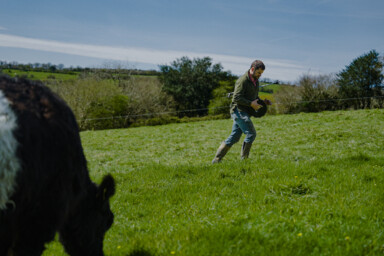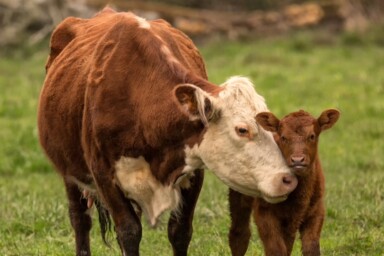
Farming reflections from 1985
Steele Addison was a prominent farmer, arboriculturist and local politician who, alongside his wife, Margaret, farmed 600 acres at Greystone House and Keld Farm in Cumbria, England. The farm remains in the family today, and, as well as producing organic food, contains a rich diversity of native woodland and nature corridors. Steele’s professional work included roles with the Country Landowners’ Association and the Association of National Parks where he was chairman from 1992 to 1995.
The following images show Steele Addison’s original typed article. If you would like to view a text-only version, please scroll to the end of these images.
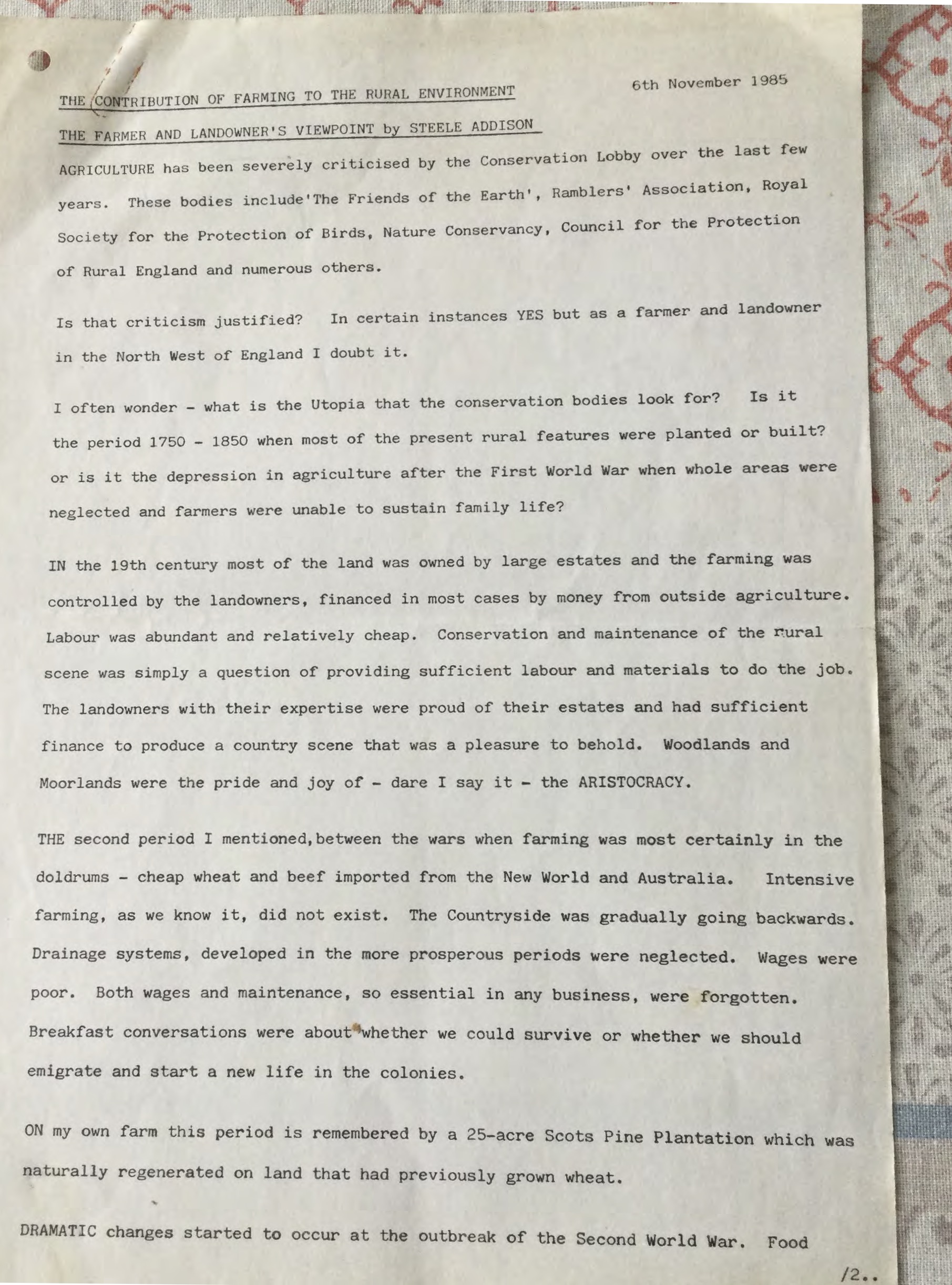
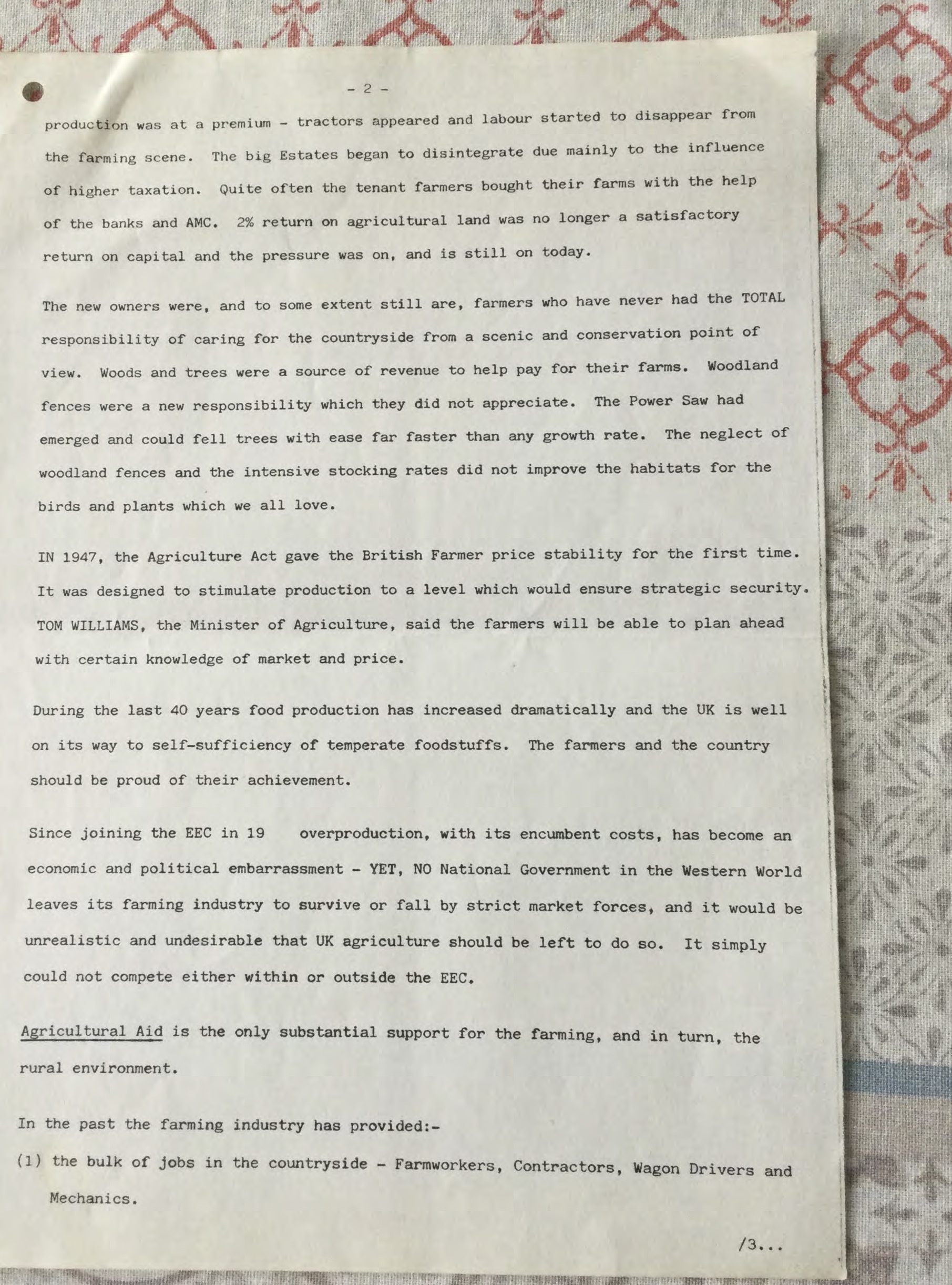
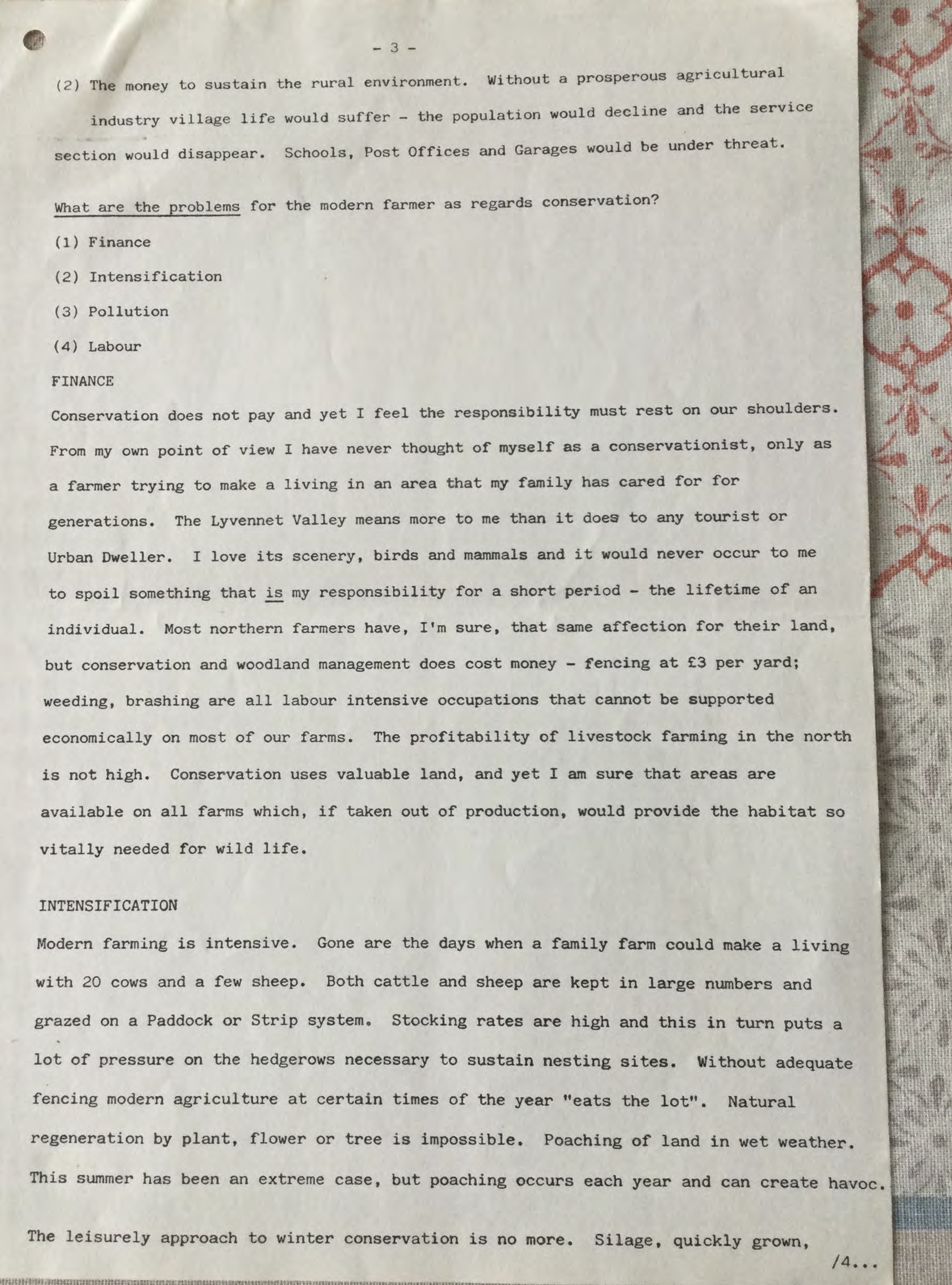
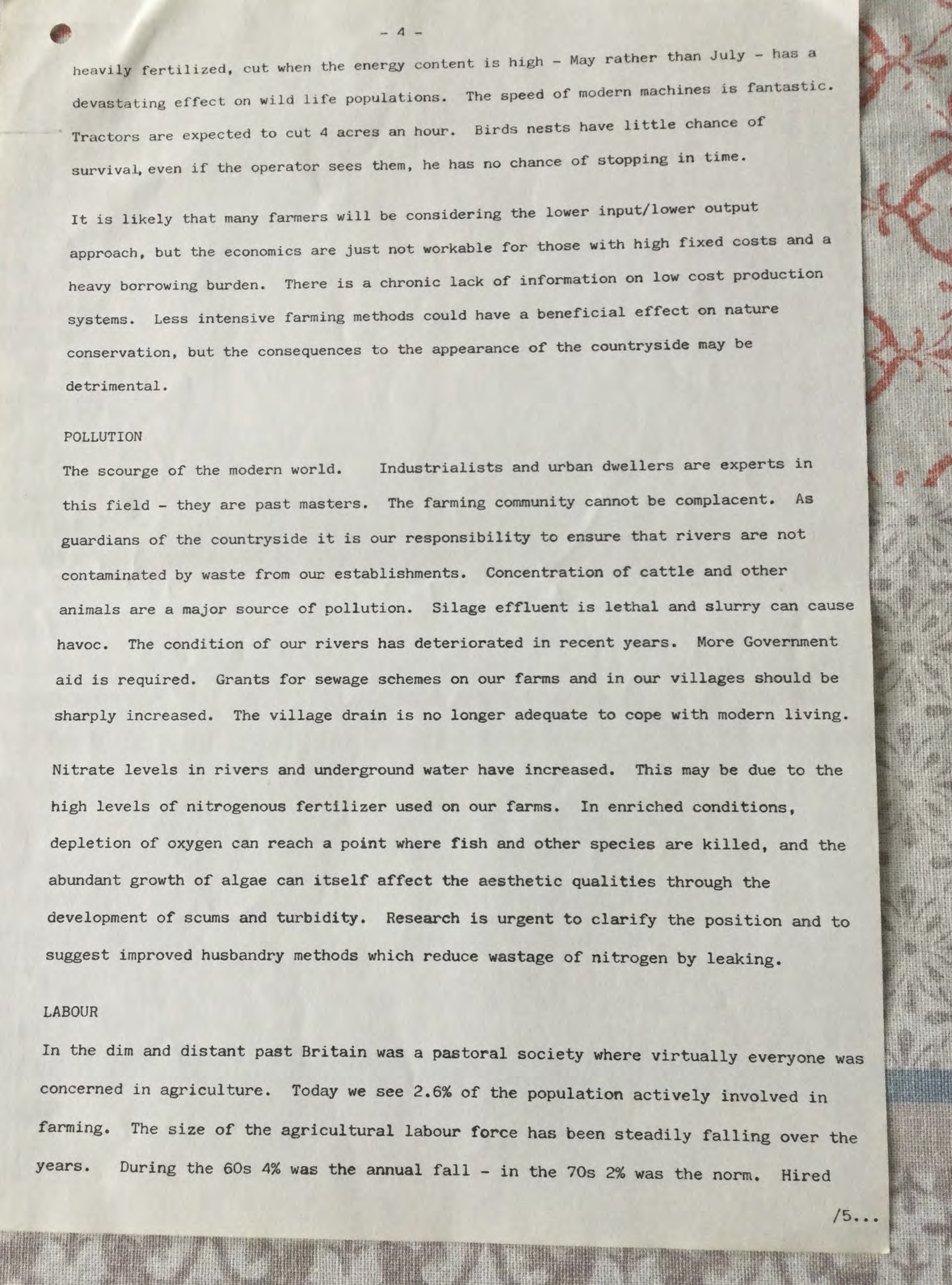
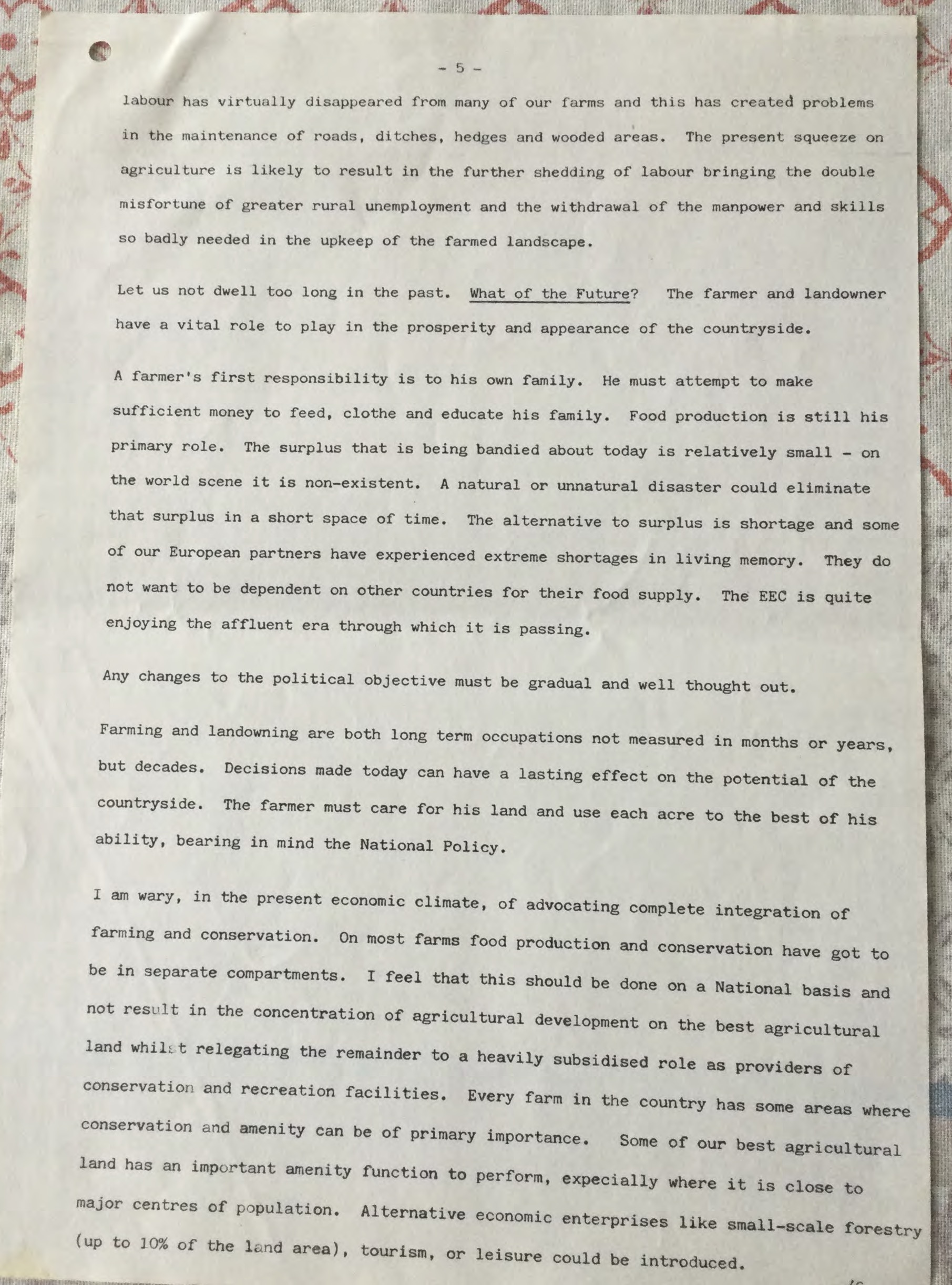
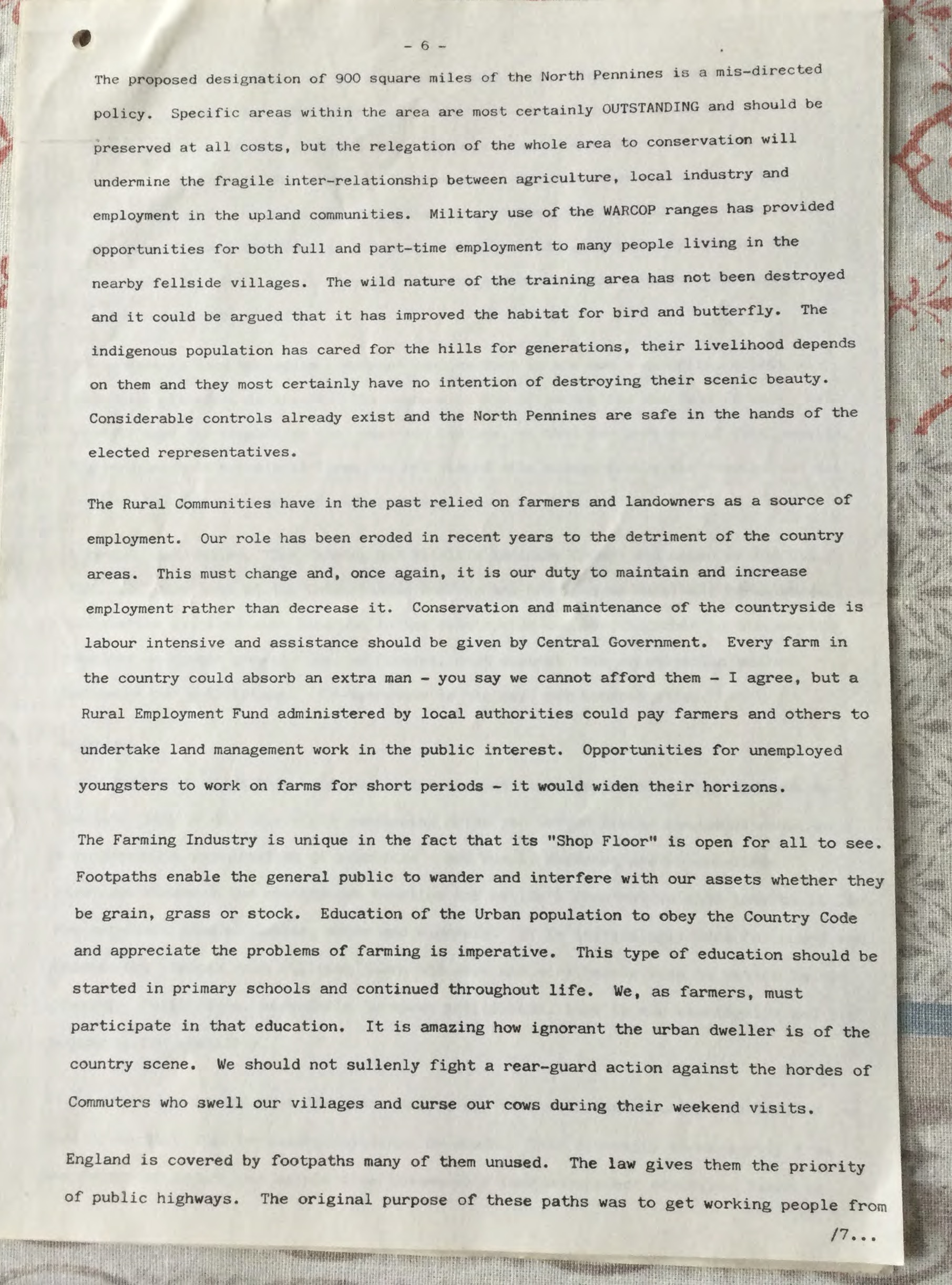
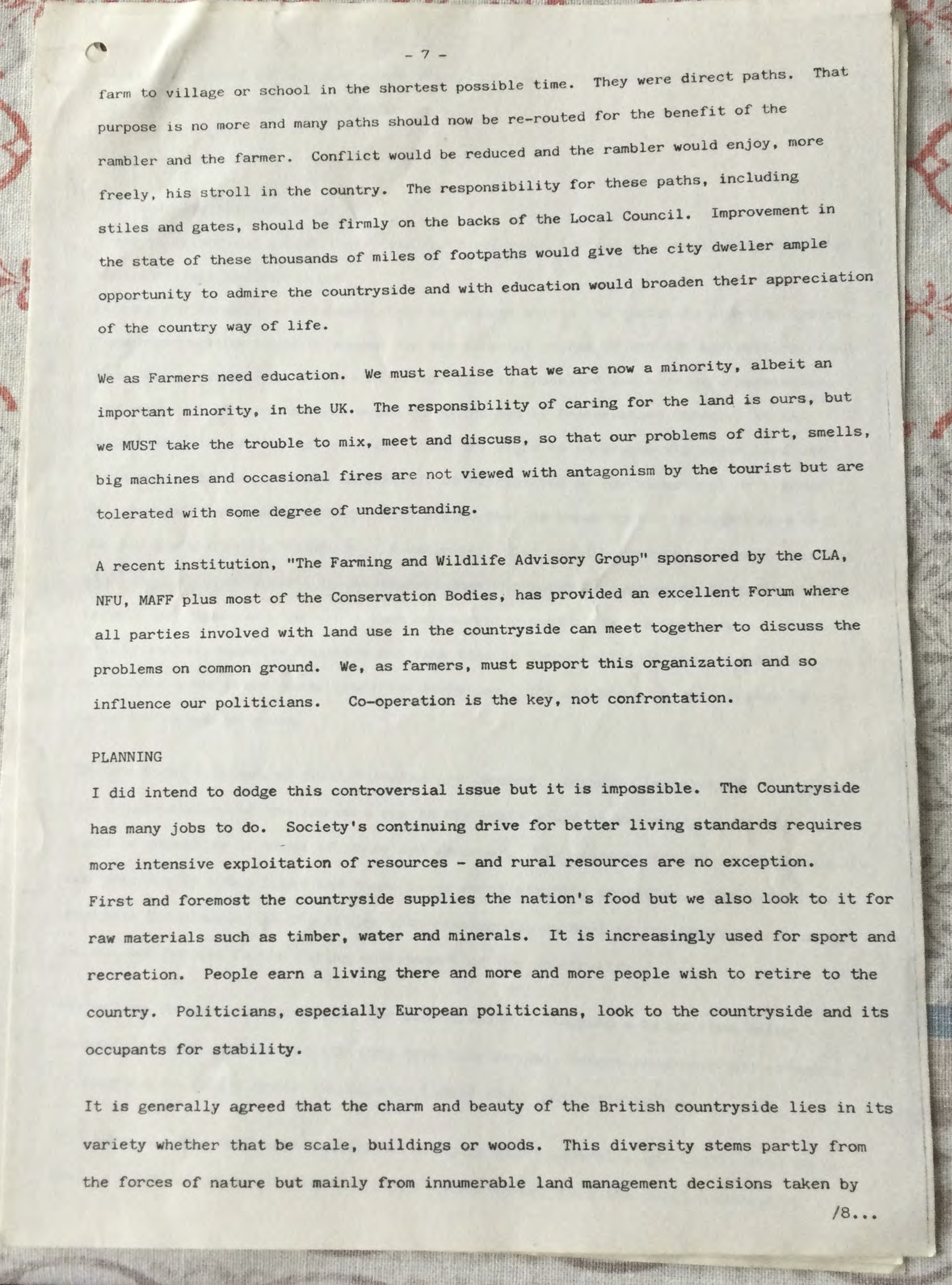
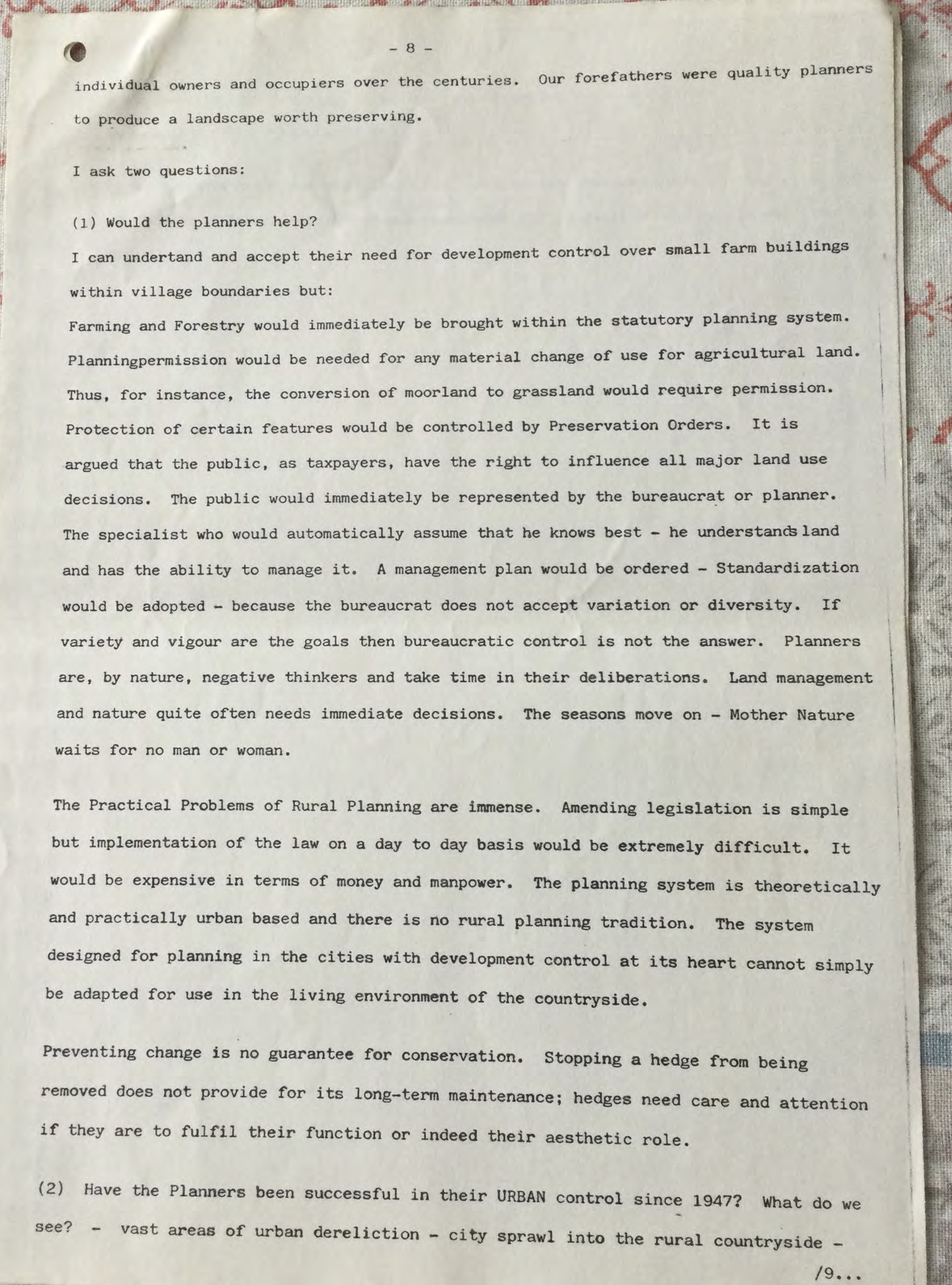

Read the transcribed version below:
THE CONTRIBUTION OF FARMING TO THE RURAL ENVIRONMENT: THE FARMER’S VIEWPOINT BY STEELE ADDISON
6th November 1985
Agriculture has been severely criticised by the conservation lobby over the last few years. These bodies include Friends of the Earth, Ramblers Association, Royal Society for the Protection of Birds, The Nature Conservancy, Council for the Protection of Rural England and numerous others.
Is that criticism justified? In certain instances, yes, but as a farmer and landowner in the northwest of England, I doubt it. I often wonder what is the Utopia that the conservation bodies look for? Is it the period 1750-1850 when most of the present rural features were planted or built? Or is it the depression in agriculture after the First World War when whole areas were neglected, and farmers were unable to sustain family life?
In the 19th century, most of the land was owned by large estates and the farming was controlled by the landowners, financed in most cases by money from outside agriculture. Labour was abundant and relatively cheap. Conservation and maintenance of the rural scene was simply a question of providing sufficient labour and materials to do the job. The landowners with their expertise were proud of their estates and had sufficient finance to produce a country scene that was a pleasure to behold. Woodlands and moorlands were the pride and joy of – dare I say it – the aristocracy.
The second period I mentioned, between the wars when farming was most certainly in the doldrums – cheap wheat and beef imported from the New World and Australia. Intensive farming, as we know it, did not exist. The countryside was gradually going backwards. Drainage systems, developed in the more prosperous periods were neglected. Wages were poor. Both wages and maintenance, so essential in any business, were forgotten. Breakfast conversations were about whether we could survive or whether we should emigrate and start a new life in the colonies.
On my own farm this period is remembered by a 25-acre Scots pine plantation which was naturally regenerated on land that had previously grown wheat.
Dramatic changes started to occur at the outbreak of the Second World War. Food production was at a premium, tractors appeared, and labour started to disappear from the farming scene. The big estates began to disintegrate due mainly to the influence of higher taxation. Quite often the tenant farmers bought their farms with the help of the banks and AMC. A 2% return on agricultural land was no longer a satisfactory return on capital and the pressure was on and is still on today.
The new owners were, and to some extent still are, farmers who have never had the total responsibility of caring for the countryside from a scenic and conservation point of view. Woods and trees were a source of revenue to help pay for their farms. Woodland fences were a new responsibility which they did not appreciate. The power saw had emerged and could fell trees with ease far faster than any growth rate. The neglect of woodland fences and the intensive stocking rates did not improve the habitats for the birds and plants which we all love.
In 1947, the Agriculture Act gave the British farmer price stability for the first time. It was designed to stimulate production to a level which would ensure strategic security. Tom Williams, the Minister of Agriculture, said the farmers will be able to plan ahead with certain knowledge of market and price.
During the last 40 years, food production has increased dramatically, and the UK is well on its way to self-sufficiency of temperate foodstuffs. The farmers and the country should be proud of their achievement.
Since joining the European Economic Community (EEC) in 1973, overproduction, with its incumbent costs, has become an economic and political embarrassment. Yet, no national government in the western world leaves its farming industry to survive or fall by strict market forces, and it would be unrealistic and undesirable that UK agriculture should be left to do so. It simply could not compete either within or outside the EEC.
Agricultural aid is the only substantial support for the farming, and in turn, the rural environment.
In the past the farming industry has provided:
- The bulk of jobs in the countryside – farmworkers, contractors, wagon drivers and mechanics.
- The money to sustain the rural environment. Without a prosperous agricultural industry, village life would suffer, the population would decline, and the service section would disappear. Schools, post offices and garages would be under threat.
What are the problems for the modern farmer as regards conservation?
- Finance
- Intensification
- Pollution
- Labour
FINANCE
Conservation does not pay and yet I feel the responsibility must rest on our shoulders. From my own point of view, I have never thought of myself as a conservationist, only as a farmer trying to make a living in an area that my family has cared for for generations. The Lyvennet Valley means more to me than it does to any tourist or Urban Dweller. I love its scenery, birds and mammals and it would never occur to me to spoil something that i my responsibility for a short period – the lifetime of an individual. Most northern farmers have, I’m sure, that same affection for their land, but conservation and woodland management does cost money, fencing at £3 per yard; weeding and brashing are all labour-intensive occupations that cannot be supported economically on most of our farms. The profitability of livestock farming in the north is not high. Conservation uses valuable land, and yet I am sure that areas are available on all farms which, if taken out of production, would provide the habitat so vitally needed for wildlife.
INTENSIFICATION
Modern farming is intensive. Gone are the days when a family farm could make a living with 20 cows and a few sheep. Both cattle and sheep are kept in large numbers and grazed on a paddock or strip system. Stocking rates are high and this in turn puts a lot of pressure on the hedgerows necessary to sustain nesting sites. Without adequate fencing modern agriculture at certain times of the year ‘eats the lot’. Natural regeneration by plant, flower or tree is impossible. Poaching of land in wet weather. This summer has been an extreme case, but poaching occurs each year and can create havoc.
The leisurely approach to winter conservation is no more. Silage, quickly grown, heavily fertilised, cut when the energy content is high – May rather than July – has a devastating effect on wildlife populations. The speed of modern machines is fantastic. Tractors are expected to cut four acres an hour. Birds’ nests have little chance of survival, even if the operator sees them, he has no chance of stopping in time.
It is likely that many farmers will be considering the lower input/lower output approach, but the economics are just not workable for those with high fixed costs and a heavy borrowing burden. There is a chronic lack of information on low-cost production systems. Less intensive farming methods could have a beneficial effect on nature conservation, but the consequences to the appearance of the countryside may be detrimental.
POLLUTION
The scourge of the modern world. Industrialists and urban dwellers are experts in this field – they are past masters. The farming community cannot be complacent. As guardians of the countryside, it is our responsibility to ensure that rivers are not contaminated by waste from our establishments. Concentration of cattle and other animals are a major source of pollution. Silage effluent is lethal, and slurry can cause havoc. The condition of our rivers has deteriorated in recent years. More government aid is required. Grants for sewage schemes on our farms and in our villages should be sharply increased. The village drain is no longer adequate to cope with modern living.
Nitrate levels in rivers and underground water have increased. This may be due to the high levels of nitrogenous fertilizer used on our farms. In enriched conditions, depletion of oxygen can reach a point where fish and other species are killed, and the abundant growth of algae can itself affect the aesthetic qualities through the development of scums and turbidity. Research is urgent to clarify the position and to suggest improved husbandry methods which reduce wastage of nitrogen by leaking.
LABOUR
In the dim and distant past Britain was a pastoral society where virtually everyone was concerned in agriculture. Today we see 2.6% of the population actively involved in farming. The size of the agricultural labour force has been steadily falling over the years. During the 1960s, 4% was the annual fall – in the 1970s, 2% was the norm. Hired labour has virtually disappeared from many of our farms and this has created problems in the maintenance of roads, ditches, hedges and wooded areas. The present squeeze on agriculture is likely to result in the further shedding of labour bringing the double misfortune of greater rural unemployment and the withdrawal of the manpower and skills so badly needed in the upkeep of the farmed landscape.
Let us not dwell too long in the past. What of the Future? The farmer and landowner have a vital role to play in the prosperity and appearance of the countryside.
A farmer’s first responsibility is to his own family. He must attempt to make sufficient money to feed, clothe and educate his family. Food production is still his primary role. The surplus that is being bandied about today is relatively small, on the world scene it is non-existent. A natural or unnatural disaster could eliminate that surplus in a short space of time. The alternative to surplus is shortage and some of our European partners have experienced extreme shortages in living memory. They do not want to be dependent on other countries for their food supply. The EEC is quite enjoying the affluent era through which it is passing.
Any changes to the political objective must be gradual and well thought out.
Farming and landowning are both long term occupations not measured in months or years, but decades. Decisions made today can have a lasting effect on the potential of the countryside. The farmer must care for his land and use each acre to the best of his ability, bearing in mind the National Policy.
I am wary, in the present economic climate, of advocating complete integration of farming and conservation. On most farms food production and conservation have got to be in separate compartments. I feel that this should be done on a national basis and not result in the concentration of agricultural development on the best agricultural land whilst relegating the remainder to a heavily subsidised role as providers of conservation and recreation facilities. Every farm in the country has some areas where conservation and amenity can be of primary importance. Some of our best agricultural land has an important amenity function to perform, especially where it is close to major centres of population. Alternative economic enterprises like small-scale forestry (up to 10% of the land area), tourism or leisure could be introduced.
The proposed designation of 900 square miles of the North Pennines is a misdirected policy. Specific areas within the area are most certainly outstanding and should be preserved at all costs, but the relegation of the whole area to conservation will undermine the fragile inter-relationship between agriculture, local industry and employment in the upland communities. Military use of the Warcop ranges has provided opportunities for both full and part-time employment to many people living in the nearby fellside villages. The wild nature of the training area has not been destroyed and it could be argued that it has improved the habitat for bird and butterfly. The indigenous population has cared for the hills for generations, their livelihood depends on them, and they most certainly have no intention of destroying their scenic beauty. Considerable controls already exist, and the North Pennines are safe in the hands of the elected representatives.
The rural communities have in the past relied on farmers and landowners as a source of employment. Our role has been eroded in recent years to the detriment of the country areas. This must change and, once again, it is our duty to maintain and increase employment rather than decrease it. Conservation and maintenance of the countryside is labour intensive, and assistance should be given by central government. Every farm in the country could absorb an extra man – you say we cannot afford them – I agree, but a rural employment fund administered by local authorities could pay farmers and others to undertake land management work in the public interest. Opportunities for unemployed youngsters to work on farms for short periods – it would widen their horizons.
The farming industry is unique in the fact that its ‘shop floor’ is open for all to see. Footpaths enable the general public to wander and interfere with our assets whether be grain, grass or stock. Education of the urban population to obey the Country Code and appreciate the problems of farming is imperative. This type of education should be started in primary schools and continued throughout life. We, as farmers, must participate in that education. It is amazing how ignorant the urban dweller is of the country scene. We should not sullenly fight a rear-guard action against the hordes of commuters who swell our villages and curse our cows during their weekend visits.
England is covered by footpaths many of them unused. The law gives them the priority of public highways. The original purpose of these paths was to get working people from farm to village or school in the shortest possible time. They were direct paths. That purpose is no more, and many paths should now be re-routed for the benefit of the rambler and the farmer. Conflict would be reduced, and the rambler would enjoy, more freely, his stroll in the country. The responsibility for these paths, including stiles and gates, should be firmly on the backs of the local council. Improvement in the state of these thousands of miles of footpaths would give the city dweller ample opportunity to admire the countryside and with education would broaden their appreciation of the country way of life.
We as farmers need education. We must realise that we are now a minority, albeit an important minority, in the UK. The responsibility of caring for the land is ours, but we must take the trouble to mix, meet and discuss, so that our problems of dirt, smells, big machines and occasional fires are not viewed with antagonism by the tourist but are tolerated with some degree of understanding.
A recent institution, The Farming and Wildlife Advisory Group sponsored by the CLA, NFU, MAFF plus most of the conservation bodies, has provided an excellent forum where all parties involved with land use in the countryside can meet together to discuss the problems on common ground. We, as farmers, must support this organisation and so influence our politicians. Co-operation is the key, not confrontation.
PLANNING
I did intend to dodge this controversial issue, but it is impossible. The countryside has many jobs to do. Society’s continuing drive for better living standards requires more intensive exploitation of resources and rural resources are no exception. First and foremost, the countryside supplies the nation’s food, but we also look to it for raw materials such as timber, water and minerals. It is increasingly used for sport and recreation. People earn a living there and more and more people wish to retire to the country. Politicians, especially European politicians, look to the countryside and its occupants for stability.
It is generally agreed that the charm and beauty of the British countryside lies in its variety whether that be scale, buildings or woods. This diversity stems partly from the force of nature but mainly from innumerable land management decisions taken by individual owners and occupiers over the centuries. Our forefathers were quality planners to produce a landscape worth preserving.
I ask two questions:
1. Would the planners help?
I can understand and accept their need for development control over small farm buildings within village boundaries but:
Farming and forestry would immediately be brought within the statutory planning system. Planning permission would be needed for any material change of use for agricultural land. Thus, for instance, the conversion of moorland to grassland would require permission. Protection of certain features would be controlled by Preservation Orders. It is argued that the public, as taxpayers, have the right to influence all major land use decisions. The public would immediately be represented by the bureaucrat or planner. The specialist who would automatically assume that he knows best – he understands land and has the ability to manage it. A management plan would be ordered – standardisation would be adopted because the bureaucrat does not accept variation or diversity. If variety and vigour are the goals, then bureaucratic control is not the answer. Planners are, by nature, negative thinkers and take time in their deliberations. Land management and nature quite often needs immediate decisions. The seasons move on – Mother Nature waits for no man or woman.
The practical problems of rural planning are immense. Amending legislation is simple but implementation of the law on a day-to-day basis would be extremely difficult. It would be expensive in terms of money and manpower. The planning system is theoretically and practically urban based and there is no rural planning tradition. The system designed for planning in the cities with development control at its heart cannot simply be adapted for use in the living environment of the countryside.
Preventing change is no guarantee for conservation. Stopping a hedge from being removed does not provide for its long-term maintenance; hedges need care and attention if they are to fulfil their function or indeed their aesthetic role.
2. Have the planners been successful in their urban control since 1947?
What do we see? Vast areas of urban dereliction, city sprawl into the rural countryside, large tower blocks badly built needing attention – I could go on. My answer to full planning is no.
Conservationists can say what they like. Politicians can legislate as they will, but the future of rural environment depends on the goodwill of the people who live and work there.
We would like to thank Steele Addison’s family for their permission to share his writing and the photographs contained in this article.



